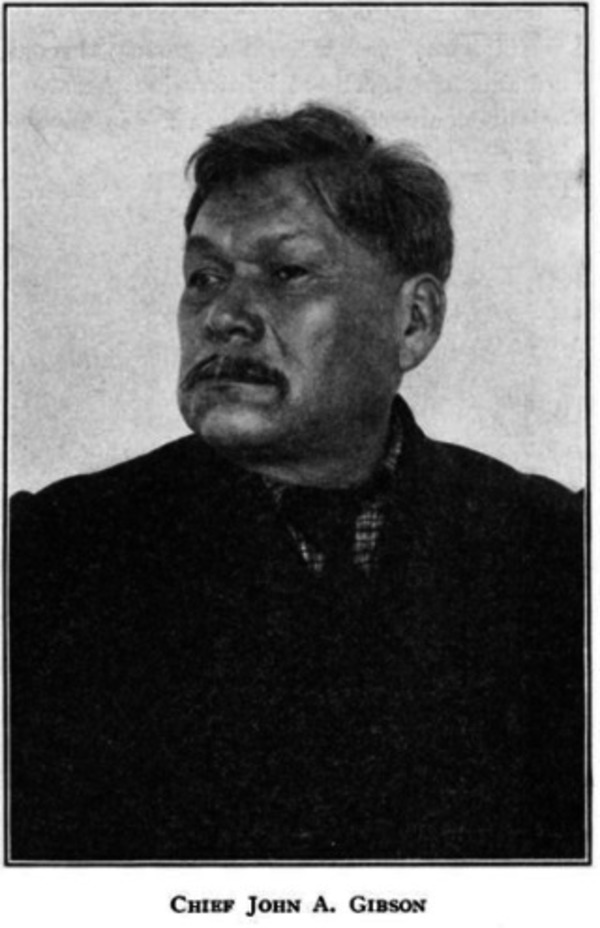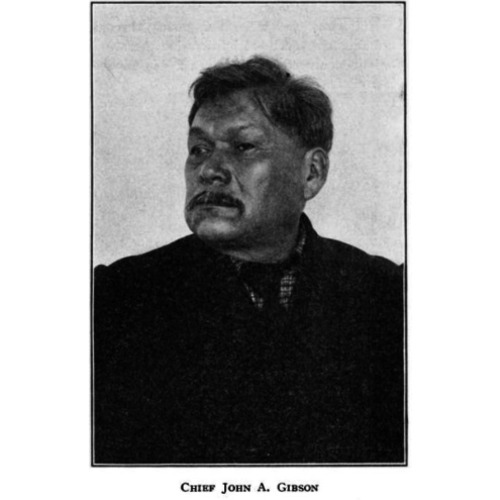
Source: Link
GIBSON, JOHN ARTHUR, lacrosse player, craftsman, Seneca chief, preacher, and Iroquoian traditionalist; b. 1 March 1850 in Tuscarora Township on the Six Nations Reserve, Upper Canada, son of Chief John Gibson and Hannah —; m. before 1871 Mary Skye, and they had at least three sons and a daughter; d. there 1 Nov. 1912.
The eldest of at least seven children, John Arthur Gibson grew up on his father’s large farm on the banks of the Grand River. His family reflected the demographic distribution of this area of the reserve: the multilingual Gibson had an Onondaga father, a Seneca mother from the Buffalo Creek Reservation (Buffalo), N.Y., and a Cayuga wife.
In his younger years Gibson, a lacrosse player of note, competed in matches with other Iroquois and also with some white teams in the Brantford area. A biography of Gibson, later written by his wife, describes the violence of these games and differences in play. At age 31 Gibson lost his sight as a result of a “strenuous” game. He reportedly suffered either an “accident” during the match or overheating that led to an illness which affected his optic nerves, producing blindness. He none the less continued for many years to manage the United Six Nations Lacrosse Team, also called the “Gibson team,” and to manufacture lacrosse sticks, which seem to have been the principal source of his reputation off the reserve.
Born into the turtle clan of the Seneca, Gibson, whose parents were Anglican, had joined at an early age the 20 per cent of the Six Nations population who embraced the beliefs of the Longhouse. Others, including census takers and some ethnologists, called them Pagans or Deists. While a young man, Gibson became the pupil of one of the oldest of the Onondaga, whose memory went back to the years before the dispersion of the Six Nations, in the aftermath of the American revolution. From him Gibson, who was never satisfied, one obituary would indicate, until he had “traced a custom or a belief back to its earliest remembered antecedents,” acquired the wide knowledge of the customs, traditions, and religion of his ancestors for which he became noted.
By 1872 Gibson had been appointed by his clan mothers to hold the hereditary title of Skanyátaí.yo? (Handsome Lake) on the Confederacy Council. As a chief, Gibson, according to one obituary, later “repeatedly represented his people in their dealings with the Canadian government, not uncommonly with signal success.” He was occasionally employed as a consultant by the Department of Indian Affairs, for which he also mediated disputes among the tribes at Six Nations and elsewhere.
Guided by his early tutelage and the example of older chiefs, notably John Buck (Skanawati), Gibson became one of the principal proponents of traditional Iroquoian ways. Among other functions, he was a keeper of traditional names, whom parents consulted when naming their children. Because of his extraordinary memory and understanding of Iroquois law and ceremonies – he was also gifted with a splendid singing voice – Gibson was much in demand as a participant in Longhouse rituals. He was one of six speakers on the Iroquois reserves of Ontario and western New York State authorized to preach the Gaiwiioh (Good Message) of the early Seneca prophet Skanyátaí.yo? (Handsome Lake), whose teachings about traditional Iroquoian religious practices had survived on the Grand despite the efforts of Christian clergymen such as Robert Lugger*. Usually attended by his son Simeon, Gibson preached annually at Grand River and at Cattaraugus, Cold Spring, and Tonawanda in New York. He was, perhaps, less conservative than some of the other speakers since he often interpolated explanatory matter during his recitation of the Gaiwiioh, which took three days.
With regard to the survival of Iroquois traditions Gibson once commented, “Another generation and there will be no custom; still another generation and there will be no memory.” Because of his concern, and his prominence, the “ever polite, somewhat formal” chief attracted a host of anthropologists and museum directors interested in documenting and preserving the heritage of the Six Nations. In the 1880s and 1890s Horatio Emmons Hale* observed and recorded Gibson’s role in Longhouse ceremonies. David Boyle of the Ontario Provincial Museum evidently visited Gibson at his Grand River farmhouse, although Boyle’s interest was tinged with a patronizing aversion to Paganism on the Six Nations Reserve. John Napoleon Brinton Hewitt, a Tuscarora employed by the Bureau of American Ethnology, recorded Gibson’s classic versions of events in Iroquoian cosmology and in 1899 took down, from Gibson’s dictation in Onondaga, the traditional structure of the Iroquois League.
This record of the league may have been, in part, a response of the hereditary chiefs to growing pressures for an elective system of government. Gibson served on the committee of chiefs appointed in 1899 by the Six Nations Council to draft the code of Dekanahwideh* – in effect the constitution of the Iroquois Confederacy – after council had rejected a version presented by Seth Newhouse [Da-yo-de-ka-ne*], which called into question some titles of chieftainship and certain of council’s procedures. The work of this committee was ratified by council in 1900 and its version of the league tradition appeared that year in English. If its principal purpose was to emphasize the legitimacy of the hereditary chiefs, Gibson was certainly the best-informed authority of his generation on the matter.
A third version of the league tradition was dictated in Onondaga by Gibson shortly before his death in 1912 to Alexander Alexandrovich Goldenweiser, who had been visiting the Grand River regularly since the summer of 1911 to collect information for the newly formed anthropological division of the Geological Survey of Canada. This version, which was not translated and published until 1992, recounts at length the league’s beginnings and the laws and rituals connected with its operations and continuance. It represents the most complete extant primary source in an Iroquoian language, and the only complete rendering of the confederacy’s Condoling Council, the ritual by which a chief was mourned and his successor “raised up.”
Gibson’s concern with preserving traditional ways dominated even his family life. His children could not recall a time when their father was not host to visiting scholars. After his death from a stroke, his family carried on his work in their own ways. His widow dictated a biography of her husband in the Cayuga language; his children Jemima and Simeon served as consultants to such anthropologists as William Nelson Fenton, and John Hardy became a Cayuga chief.
John Arthur Gibson is regarded by modern Iroquois as one of their revered elders. “Unquestionably the greatest mind of his generation among the Six Nations,” in Fenton’s estimate, he was a pillar of the Longhouse, a leading advocate of the Handsome Lake religion, and a remarkable repository of Iroquois learning. Through Gibson the traditions of the confederacy were handed down both to another generation at Grand River and, by way of the scholars for whom he was a key source, to all posterity.
[Mary Skye Gibson’s biography of her husband, which was transcribed in Cayuga by A. A. Goldenweiser from her dictation, consists of 269 half pages followed by 7 half pages of English translation covering the first 19 pages of the text. The original is held by the Canadian Museum of Civilization (Hull, Que.), can es Arch., no.1252.2. A full translation has been undertaken by Takeshi Kimura of Chicago and Chief Jacob Thomas of the Six Nations Reserve; their assistance in providing information based on this translation is appreciated. g.e.b.]
Gibson’s 1912 version of the Iroquois League tradition has been published under the title Concerning the league: the Iroquois League tradition as dictated in Onondaga by John Arthur Gibson, ed. and trans. Hanni Woodbury et al. (Winnipeg, 1992). J. N. B. Hewitt’s account of Iroquoian cosmology as explained by Gibson appears as “Iroquoian cosmology (second part),” Smithsonian Institution, Bureau of American Ethnology, Report (Washington), 43 (1925–26): 449–819.
NA, RG 31, C1, Tuscarora Township, [Ont.], 1851: 43, and agricultural census, 79; 1861: 13, and agricultural, 21; 1871, div.1: 53, and agricultural, concession 6, lot 27; 1901, div.2: 25 (mfm. at AO). Courier (Brantford, Ont.), 4 Nov. 1912. Daily Expositor (Brantford), 2 Nov. 1912. David Boyle, “Archæological report, 1898,” in Ont., Legislature, Sessional papers, 1898, no.2 (report of the minister of education), app. W. N. Fenton, “Simeon Gibson: Iroquois informant, 1889–1943,” American Anthropologist (Menasha, Wis.), new ser., 46 (1944): 231–34. A. A. Goldenweiser, “The death of Chief John A. Gibson,” American Anthropologist (Lancaster, Pa), new ser., 14 (1912): 692–94; “On Iroquois work, 1912,” in Can., Parl., Sessional papers, 1913, no.26 (reports of the anthropological div., Geological Survey of Canada), 464–75. H. [E.] Hale, “An Iroquois Condoling Council,” RSC, Trans., 2nd ser., 1 (1895), sect.ii: 45–65. A. C. Parker, “The code of Handsome Lake, the Seneca prophet,” New York State Museum, Museum Bull. (Albany, N.Y.), no.163 (1912) (reissued Oshweken, Ont., 1983); “The constitution of the Five Nations or the Iroquois book of the great law,” New York State Museum, Museum Bull., no.184 (1916). A. A. Shimony, Conservatism among the Iroquois at the Six Nations Reserve (New Haven, Conn., 1961). D. R. Snow, The Iroquois (Cambridge, Mass., and Oxford, 1994). S. M. Weaver, “The Iroquois: the Grand River Reserve in the late nineteenth and early twentieth centuries, 1875–1945,” Aboriginal Ontario: historical perspectives on the First Nations, ed. E. S. Rogers and D. B. Smith (Toronto and Oxford, 1994), 213–57.
Cite This Article
Geoffrey E. Buerger, “GIBSON, JOHN ARTHUR,” in Dictionary of Canadian Biography, vol. 14, University of Toronto/Université Laval, 2003–, accessed December 30, 2025, https://www.biographi.ca/en/bio/gibson_john_arthur_14E.html.
The citation above shows the format for footnotes and endnotes according to the Chicago manual of style (16th edition). Information to be used in other citation formats:
| Permalink: | https://www.biographi.ca/en/bio/gibson_john_arthur_14E.html |
| Author of Article: | Geoffrey E. Buerger |
| Title of Article: | GIBSON, JOHN ARTHUR |
| Publication Name: | Dictionary of Canadian Biography, vol. 14 |
| Publisher: | University of Toronto/Université Laval |
| Year of publication: | 1998 |
| Year of revision: | 1998 |
| Access Date: | December 30, 2025 |



